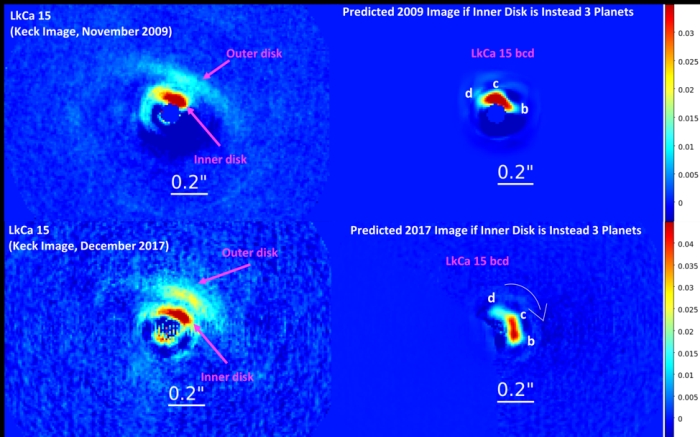Key Takeaways:
- Groundbreaking images of a forming planetary system around star LkCa 15 were captured, revealing a missing presence of three previously thought-to-exist planets.
- The innovative technique utilized by astronomers, combining the Subaru Telescope and the WM Keck Observatory, unveiled that the detected planetary light actually emanated from the disc surrounding LkCa 15, not from separate planets.
- The absence of these previously detected planets doesn’t imply a lack of planetary formation; instead, it showcases a refinement in detection methods, offering potential for more accurate future discoveries and a deeper comprehension of planetary genesis.
- The new findings suggest the potential presence of smaller, dimmer planets akin to Jupiter or Saturn, possibly embedded within the disc surrounding LkCa 15, evoking parallels to our own Solar System’s formation.
- This research opens avenues for continued exploration, aiming to uncover these elusive planets, which could significantly contribute to understanding planetary formation processes.
Recent groundbreaking revelations in the realm of astronomical observations have shed new light on the formation of planetary systems, significantly altering previous understandings. The vivid imagery captured by Hawaii’s powerful telescopes has revolutionized our perception of the planetary genesis ongoing around the young star, LkCa 15, situated a staggering 473 light-years away.
The focal point of this revelation was the absence of three planets previously assumed to exist within this celestial neighborhood. Contrary to suggesting a lack of planetary emergence, this absence unraveled a sophisticated refinement in detection techniques, promising more precise detection methodologies and a profound comprehension of planetary evolution.
Stars in their nascent stages are enveloped by a whirl of dust, rocks, and gases, forming a protoplanetary disc. Within this cosmic crucible, planetary accretion occurs as particles collide and accumulate gravitational strength, eventually birthing planets by clearing their orbital paths.
Astronomical history boasts captivating images of these protoplanetary discs, evidencing the ongoing orbital clearing. Prior explorations around LkCa 15 indicated the presence of three ‘super-Jupiter’ planets nestled within a Solar System-sized gap, a revelation challenged by recent discoveries.

The integration of the Subaru Telescope’s innovative instrument, SCExAO, and the WM Keck Observatory’s NIRC2 revealed a pivotal reality: the supposed planetary light emanated from the disc itself. This transformative understanding rectified a previous misconception, highlighting the complexity of the LkCa 15 system.
Astrophysicist Thayne Currie emphasized the intricacies of this system, acknowledging the likelihood of smaller, subtler planets existing within the disc’s confines. The quest to unearth these elusive planetary bodies persists, with implications extending beyond mere celestial exploration.
The comprehensive research, detailed in The Astrophysical Journal Letters and arXiv, leveraged archived and contemporary observations, unraveling a predominant source of light around LkCa 15—a luminous arc-shaped edge of the disc previously misconstrued as protoplanets.
This revised narrative proposes the existence of diminutive, Jupiter or Saturn-sized planets embedded within the disc, potentially mirroring the early formation stages of our Solar System. The pursuit to unveil these celestial entities promises invaluable insights into planetary genesis, unraveling cosmic mysteries while paralleling our own system’s evolution.


